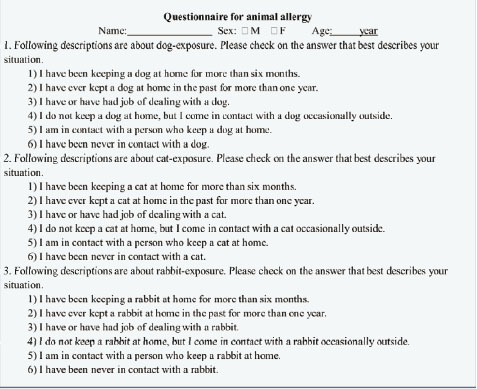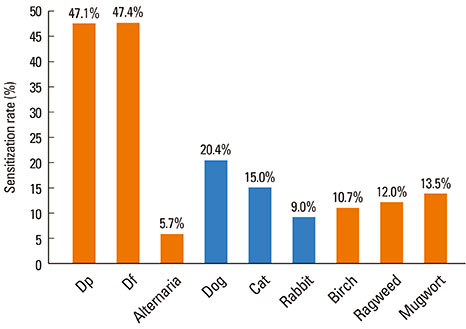Association Between Pet Ownership and the Sensitization to Pet Allergens in Adults With Various Allergic Diseases
- Affiliations
-
- 1Division of Pulmonary, Allergy and Critical Care Medicine, Department of Internal Medicine, Hallym University College of Medicine, Chuncheon, Korea. mdqueen@hallym.or.kr
- 2Lung Research Institute of Hallym University College of Medicine, Chuncheon, Korea.
- KMID: 2260810
- DOI: http://doi.org/10.4168/aair.2013.5.5.295
Abstract
- PURPOSE
As pet ownership increases, sensitization to animal allergens due to domestic exposure is a concern. Sensitization to animal allergens may occur from indirect exposure, as well as direct ownership of animals. However, there have been conflicting results regarding the association between pet ownership and sensitization to animal allergens in adults.
METHODS
In total, 401 patients with various allergic diseases were enrolled in this study. We performed skin prick tests with 55 common inhalant and food allergens, including dog, cat, and rabbit allergens. A mean wheal diameter of 3 mm or greater was considered a positive reaction. The exposure modality to each animal allergen was investigated using a questionnaire and included present ownership, past ownership, occupational exposure, occasional exposure, contact with pet owner, and no contact. Present ownership, past ownership, occupational, and occasional exposure were regarded as direct exposure.
RESULTS
The sensitization rate for animal allergens was 20.4% for dog, 15.0% for cat, and 9.0% for rabbit. Direct exposure to dogs (72.0%) was significantly higher than that of other animals (18.4% for cats and 16.7% for rabbits), whereas 'no contact' with cats (78.3%) and rabbits (83.3%) was significantly higher than with dogs (26.8%; P<0.0001). Independent risk factors for sensitization to animal allergens were sensitization to Dermatophagoides pteronyssinus (OR=2.4, P=0.052), Dermatophagoides farinae (OR=5.1, P<0.001), cat (OR=4.4, P<0.0001), and direct exposure to dogs (OR=1.5, P=0.029) for dog, and sensitization to dog (OR=4.4, P<0.0001) and rabbit (OR=2.6, P=0.036) for cats. Finally, for rabbits, the independent risk factor was sensitization to Alternaria (OR=6.0, P<0.002).
CONCLUSIONS
These results suggest that direct exposure to dogs contributes to the sensitization to dog allergens in patients with allergic diseases, whereas indirect exposure to cats and rabbits may induce sensitization to each animal's allergen.
MeSH Terms
Figure
Cited by 4 articles
-
Risk Factors and Comorbidities Associated With the Allergic Rhinitis Phenotype in Children According to the ARIA Classification
Sungsu Jung, So-Yeon Lee, Jisun Yoon, Hyun-Ju Cho, Young-Ho Kim, Dong In Suh, Song-I Yang, Ji-won Kwon, Gwang Cheon Jang, Yong Han Sun, Sung-Il Woo, You-Sook Youn, Kang Seo Park, Eun Lee, Hwa Jin Cho, Myung-Hee Kook, Hye Ryoung Yi, Hai Lee Chung, Ja Hyeong Kim, Hyung Young Kim, Jin A Jung, Hyang-Ok Woo, Jeom-Kyu Lee, Woo-Sung Chang, Nam Hee Do, Hyejoo Cho, Soo-Jong Hong
Allergy Asthma Immunol Res. 2020;12(1):72-85. doi: 10.4168/aair.2020.12.1.72.Sensitization to animal allergens and allergic symptoms during exposure to them in Korean veterinary researchers
Hong Suk Park, Jungwoo Shim, Eun Yeong Cho, Chana Myoung, Sojung Lee, Young Jae Kwon, Sang Min Lee, Jeong-Woong Park, Sung Hwan Jeong, Sang Pyo Lee
Allergy Asthma Respir Dis. 2016;4(6):406-414. doi: 10.4168/aard.2016.4.6.406.Dog and Cat Allergies and Allergen Avoidance Measures in Korean Adult Pet Owners Who Participated in a Pet Exhibition
Min Suk Yang, Sang Pyo Lee, Young Jae Kwon, Sang Min Lee
Allergy Asthma Immunol Res. 2018;10(2):155-164. doi: 10.4168/aair.2018.10.2.155.Age Differences in Pet Sensitization by Pet Ownership
Jun Yeon Won, Jea-Woo Kwon, Seung-No Hong, Woo Hyun Lee
Clin Exp Otorhinolaryngol. 2021;14(2):210-216. doi: 10.21053/ceo.2020.00675.
Reference
-
1. Bush RK, Wood RA, Eggleston PA. Laboratory animal allergy. J Allergy Clin Immunol. 1998; 102:99–112.2. Simpson A, Custovic A. Pets and the development of allergic sensitization. Curr Allergy Asthma Rep. 2005; 5:212–220.3. Noertjojo K, Dimich-Ward H, Obata H, Manfreda J, Chan-Yeung M. Exposure and sensitization to cat dander: asthma and asthma-like symptoms among adults. J Allergy Clin Immunol. 1999; 103:60–65.4. Plaschke P, Janson C, Norrman E, Björnsson E, Ellbjär S, Järvholm B. Association between atopic sensitization and asthma and bronchial hyperresponsiveness in swedish adults: pets, and not mites, are the most important allergens. J Allergy Clin Immunol. 1999; 104:58–65.5. Yoo KY, Cho SH, Gin Y, Lee YJ. Strategic guidelines to protect and manage pet animals in Seoul (SDI 04-R-21). Seoul: The Seoul Institute;2004.6. Kim TB, Kim KM, Kim SH, Kang HR, Chang YS, Kim CW, Bahn JW, Kim YK, Kang HT, Cho SH, Park HS, Lee JM, Choi IS, Min KU, Hong CS, Kim NS, Kim YY. Sensitization rates for inhalant allergens in Korea; a multi-center study. J Asthma Allergy Clin Immunol. 2003; 23:483–493.7. Liccardi G, Passalacqua G. Sensitization to rabbit allergens in Italy--a multicentre study in atopic subjects without occupational exposure. Int Arch Allergy Immunol. 2006; 141:295–299.8. Ownby DR, Johnson CC, Peterson EL. Exposure to dogs and cats in the first year of life and risk of allergic sensitization at 6 to 7 years of age. JAMA. 2002; 288:963–972.9. Van Gysel D, Govaere E, Verhamme K, Doli E, De Baets F. Exposure to pets and the association with sensitization and allergic disease in Belgian schoolchildren. Allergy. 2009; 64:663–664.10. Linneberg A, Nielsen NH, Madsen F, Frølund L, Dirksen A, Jørgensen T. Pets in the home and the development of pet allergy in adulthood. The Copenhagen Allergy Study. Allergy. 2003; 58:21–26.11. Roost HP, Künzli N, Schindler C, Jarvis D, Chinn S, Perruchoud AP, Ackermann-Liebrich U, Burney P, Wüthrich B. Role of current and childhood exposure to cat and atopic sensitization. European Community Respiratory Health Survey. J Allergy Clin Immunol. 1999; 104:941–947.12. Custovic A, Hallam CL, Simpson BM, Craven M, Simpson A, Woodcock A. Decreased prevalence of sensitization to cats with high exposure to cat allergen. J Allergy Clin Immunol. 2001; 108:537–539.13. Kim KH, Kim KT, Lee SK, Park HS, Lee YM, Nahm DH, Son CH, Yang DK, Roh MS, Choi PJ, Lee JH, Kim KN, Lee KN. Sensitization rates for inhalant allergens in patients with respiratory allergy in Busan. Korean J Asthma Allergy Clin Immunol. 2005; 25:59–63.14. Lee MK, Lee WY, Yong SJ, Shin KC, Lee SN, Lee SJ, Lee JH, Jung S, Jung YR, Kim SH. Sensitization rates to inhalant allergens in patients visiting a university hospital in Gangwon region. Korean J Asthma Allergy Clin Immunol. 2011; 31:27–32.15. Yoon BJ, Kim SH, Kim DH, Koh YI. Longitudinal changes of sensitization rates to inhalant allergens in patients with allergic diseases from Gwangju and Chonnam areas: their association with annual changes in temperature. Korean J Asthma Allergy Clin Immunol. 2011; 31:93–104.16. Kim JY. Serological and molecular biological survey of Toxoplasma gondii infection in neutralized stray and household cats in Seoul [thesis]. Chuncheon: Kangwon National University;2010.17. Boutin Y, Hébert H, Vrancken ER, Mourad W. Allergenicity and cross-reactivity of cat and dog allergenic extracts. Clin Allergy. 1988; 18:287–293.18. Reininger R, Varga EM, Zach M, Balic N, Lindemeier AD, Swoboda I, Grönlund H, van Hage M, Rumpold H, Valenta R, Spitzauer S. Detection of an allergen in dog dander that cross-reacts with the major cat allergen, Fel d 1. Clin Exp Allergy. 2007; 37:116–124.19. Madhurantakam C, Nilsson OB, Uchtenhagen H, Konradsen J, Saarne T, Högbom E, Sandalova T, Grönlund H, Achour A. Crystal structure of the dog lipocalin allergen Can f 2: implications for cross-reactivity to the cat allergen Fel d 4. J Mol Biol. 2010; 401:68–83.20. Galant S, Berger W, Gillman S, Goldsobel A, Incaudo G, Kanter L, Machtinger S, McLean A, Prenner B, Sokol W, Spector S, Welch M, Ziering W. Prevalence of sensitization to aeroallergens in California patients with respiratory allergy. Allergy Skin Test Project Team. Ann Allergy Asthma Immunol. 1998; 81:203–210.21. Choi JH, Kim HM, Park HS. Allergic asthma and rhinitis caused by household rabbit exposure: identification of serum-specific IgE and its allergens. J Korean Med Sci. 2007; 22:820–824.22. Svanes C, Dharmage S, Sunyer J, Zock JP, Norbäck D, Wjst M, Heinrich J, Jarvis D, de Marco R, Plana E, Villani S, Antó JM. Long-term reliability in reporting of childhood pets by adults interviewed twice, 9 years apart. Results from the European Community Respiratory Health Survey I and II. Indoor Air. 2008; 18:84–92.23. Svanes C, Zock JP, Antó J, Dharmage S, Norbäck D, Wjst M, Heinrich J, Jarvis D, de Marco R, Plana E, Raherison C, Sunyer J. Early Life Working Group of the European Community Respiratory Health Survey. Do asthma and allergy influence subsequent pet keeping? An analysis of childhood and adulthood. J Allergy Clin Immunol. 2006; 118:691–698.
- Full Text Links
- Actions
-
Cited
- CITED
-
- Close
- Share
- Similar articles
-
- Age Differences in Pet Sensitization by Pet Ownership
- Change of Inhalant Allergen Sensitization in Children with Allergic Respiratory Diseases during Recent 10 Years
- Determinants of sensitization to allergen in infants and young children
- Dog and Cat Allergies and Allergen Avoidance Measures in Korean Adult Pet Owners Who Participated in a Pet Exhibition
- Sensitization to Inhalant Allergens and Its Association with Allergic Diseases in Preschool Children



